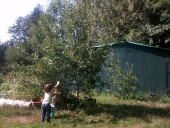








I make a Maple Syrup instructional movie! Check it out HERE
SKIP books, get 'em while they're hot!!! Skills to Inherit Property
See me in a movie building a massive wood staircase:Low Tech Lab Movie




http://www.popcliq.com (web development), GoPermaculture Food Forest http://www.permies.com/t/57687/forest-garden/Permaculture-Food-Forest-suburban-permaculture, Sea Buckthorn (Seaberry) grower (hobbiest) https://www.facebook.com/michelle.bisson.37, zone 3b/4b (borderline) Quebec Canada
 1
1





 1
1




List of Bryant RedHawk's Epic Soil Series Threads We love visitors, that's why we live in a secluded cabin deep in the woods. "Buzzard's Roost (Asnikiye Heca) Farm." Promoting permaculture to save our planet.
 1
1




Checkout Arboractive.com.
It is under construction but being filled with all sorts of neat outdoors and tree related conversation!




http://www.popcliq.com (web development), GoPermaculture Food Forest http://www.permies.com/t/57687/forest-garden/Permaculture-Food-Forest-suburban-permaculture, Sea Buckthorn (Seaberry) grower (hobbiest) https://www.facebook.com/michelle.bisson.37, zone 3b/4b (borderline) Quebec Canada




"The rule of no realm is mine. But all worthy things that are in peril as the world now stands, these are my care. And for my part, I shall not wholly fail in my task if anything that passes through this night can still grow fairer or bear fruit and flower again in days to come. For I too am a steward. Did you not know?" Gandolf












 3
3




Michelle Bisson wrote:Also, trimming back the dying branches, "might" give new vigor to the tree.
List of Bryant RedHawk's Epic Soil Series Threads We love visitors, that's why we live in a secluded cabin deep in the woods. "Buzzard's Roost (Asnikiye Heca) Farm." Promoting permaculture to save our planet.
 1
1




Bryant RedHawk wrote:
Michelle Bisson wrote:Also, trimming back the dying branches, "might" give new vigor to the tree.
Very true Michelle, Dead wood left on a tree actually sucks life from the tree. That's why you always start a pruning by taking out all dead wood.
I forgot in my earlier post to mention that you need to inspect this tree for borer holes, this is one of the prime reasons large healthy looking trees start to die, they have grubs inside that are eating the cambium layers and killing it slowly.
Checkout Arboractive.com.
It is under construction but being filled with all sorts of neat outdoors and tree related conversation!

| I agree. Here's the link: http://stoves2.com |


